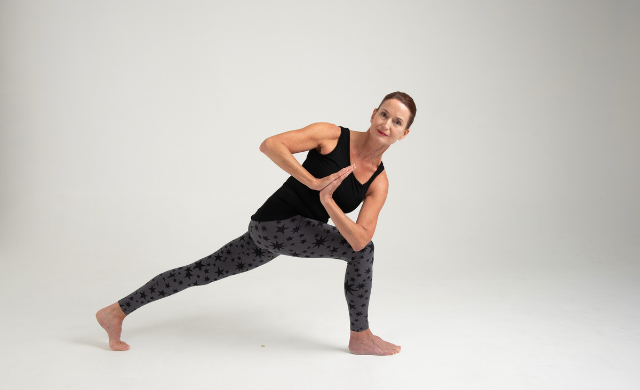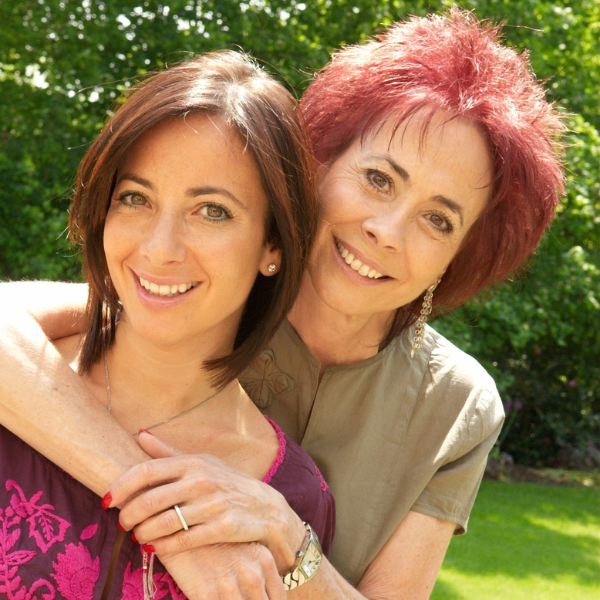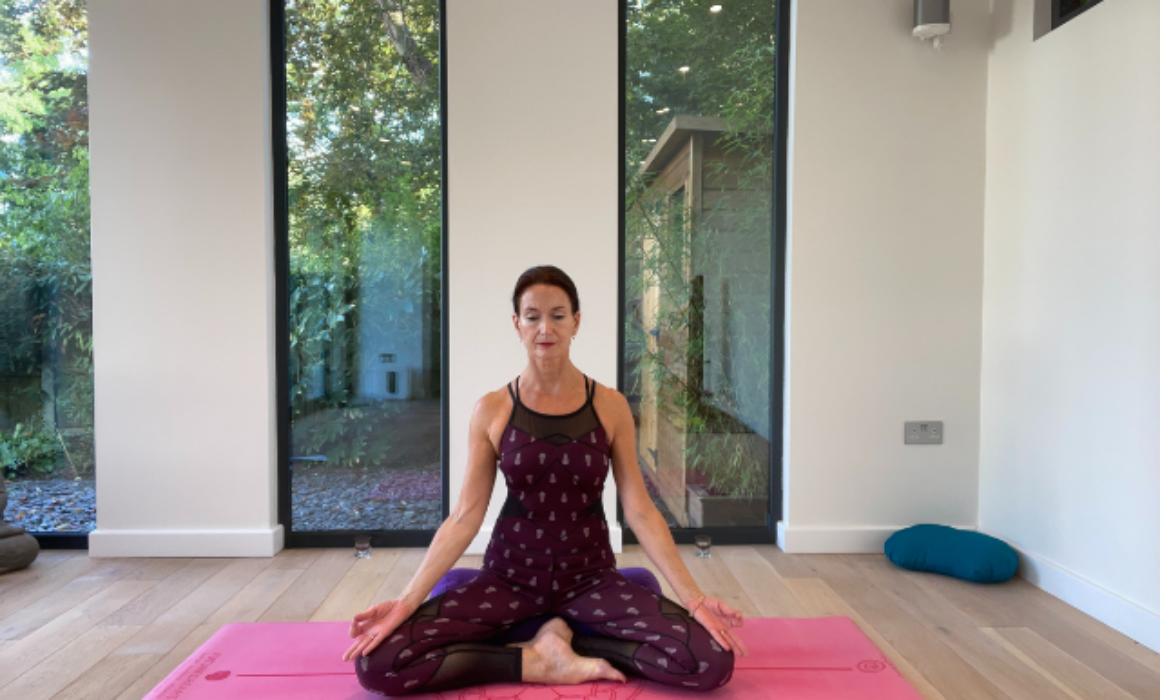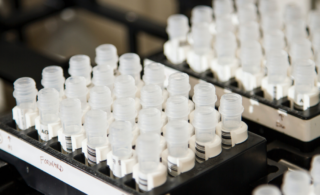
Yoga can help with recovery after breast cancer treatment and in this personal story, Marcia – yoga teacher and yoga for cancer specialist – shares how yoga helped her find peace and balance after finishing breast cancer treatment.
By Marcia
My journey to yoga
My experience of breast cancer, at the age of 32, left me feeling shell-shocked and overwhelmed. Moving forwards with life was not as easy as I’d imagined; I felt that my whole body was out of balance, physically, mentally and emotionally. Yoga helped me find balance after breast cancer.
My GP suggested counselling, but it wasn’t for me. Back in 1998, there was a lot in the media around yoga, so I thought I’d give it a try. I loved the physical practice – the strength building and discipline of holding postures for several breaths. I’d leave each yoga class feeling energised yet relaxed and calm. It made me feel alive and in control of my body.
I was hooked after that first class, finding a practice and philosophy that resonated with me. I explored many styles of yoga over the years and built my practice up slowly and consistently. This is very important, especially if you are a coming to yoga as a beginner or through breast cancer. Yoga teaches you to practise patience, to listen to your body and become more interoceptive, sensing the internal state of the body.
Having experienced yoga’s therapeutic benefits first-hand, I wanted to specialise in teaching yoga to those with breast cancer. In 2016, I undertook a general yoga teacher training, then trained to become a specialist Yoga for Cancer teacher and recently qualified as a Yoga Therapist.

How can yoga help?
Yoga has been proven to effectively reduce several side effects of breast cancer. One of the most common side effects is fatigue. The solution for fatigue isn’t necessarily rest; moving the body through a sequence of yoga poses in time with the breath can draw fresh energy (prana) into the body and leave you feeling uplifted and energised. I always include half sun salutations into my yoga for breast cancer classes. When we move the whole body with the breath, it increases heart rate, stimulating the flow of blood, as well as moving lymphatic fluid around the body. This is especially helpful to counteract the effects of lymphoedema.
Another common side effect that I see in my yoga for breast cancer students is reduced lower body strength. Lack of movement, due to fatigue or nausea, can weaken muscles in the legs. Standing poses such as Warriors I, II and III are effective in building back strength in the glutes and quadriceps. Holding standing poses for several breaths can also help build back bone density and reduce the effects of osteopenia and osteoporosis.
After my mastectomy and reconstruction, I needed to build back strength and mobility into my upper body to regain normal functional movement. (I remember longing to be able to do mundane chores like hanging out washing or making a bed.) Many yoga poses are ideal for addressing this. Child pose is a good example as it stretches the side body, armpits and shoulders and can be modified with the use of yoga props. It has a restorative effect on the whole body, whilst allowing scar tissue to lengthen and release.
How to get started
Yoga provides many benefits to those with breast cancer both before, during and after treatment. It is best practised under the guidance of a specially trained Yoga for Cancer teacher.
I offer weekly online classes, via Zoom, which focus on calming the body and mind, as well as building strength and mobility into the body. Before joining a group class, I hold a phone call to learn about a potential student’s diagnosis and treatment. After this, I recommend a private lesson on Zoom, as this allows me to observe the student closely and gain feedback as they move through their practice before joining the group.
I also teach weekly classes at Future Dreams every Tuesday 2-3pm, as well as with the GetMeBack cancer recovery community every other Thursday lunchtime. If you can’t find a specialist teacher, look for a beginner level Hatha or Iyengar class and tell the teacher of your condition before the class begins, so that poses can be modified. Some poses taught in a regular yoga class, such as plank and downward facing dog, are not suitable for someone who is recovering from breast cancer.
What do I need to take my first yoga class?
If it’s your first-time trying yoga, just make sure you’re wearing comfortable clothing that is easy to move in – you don’t need the latest leggings! If you want to invest in anything, buy your own mat. A basic yoga mat costs around £22 and needs to be quite thin, around 4-5mm. If you’re attending a studio class, you can use mats they provide. Get creative with home props, using sturdy books instead of yoga blocks and a dressing gown belt for a yoga strap.
Get in touch
My online Yoga for Breast Cancer classes can be practised from the comfort of home with the advantage of people all over the country having access to them. Breast cancer can be a very isolating experience, especially during the recent lockdown, so coming together to practise yoga in a supportive community can be helpful in combating isolation. Visit my website: www.marcie.yoga and Instagram @yogaforbreastcancer for further details.
To return to the homepage of our Information Hub, click here where you can access more helpful information, practical advice, personal stories and more.
Future Dreams hold a range of support groups, classes, workshops and events to help you and your carers during your breast cancer diagnosis – including yoga classes run by Marcia. These are held both online and in person at the London-based Future Dreams House. To see what’s on offer and to book your place, see here.
October 2021 (Reviewed May 2024)
This article was written by a guest author based on their own experience of breast cancer and its treatment. It is important to note that this is one person’s experience and that whilst there may be commonalities between the experiences of different people, everyone has a different diagnosis/treatment plan/general experience. The information and content provided in all guest articles is intended for information and educational purposes only and is not intended to substitute for professional medical advice. It is important that all personalised care decisions should be made by your medical team. Please contact your medical team for advice on anything covered in this article and/or in relation to your personal situation. Please note that unless otherwise stated, Future Dreams has no affiliation to the guest author of this article and he/she/they have not been paid to write this article. There may be alternative options/products/information available which we encourage you to research when making decisions about treatment and support.
Share

Support awareness research
Donate to those touched by BREAST cancer
Sylvie and Danielle began Future Dreams with just £100 in 2008. They believed nobody should face breast cancer alone. Their legacy lives on in Future Dreams House. We couldn’t continue to fund support services for those touched by breast cancer, raise awareness of breast cancer and promote early diagnosis and advance research into secondary breast cancer without your help. Please consider partnering with us or making a donation.



